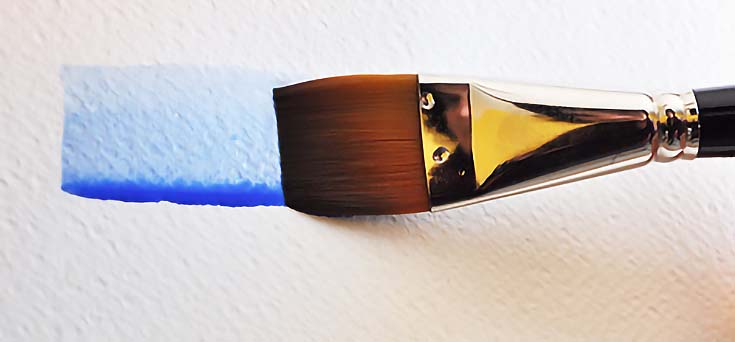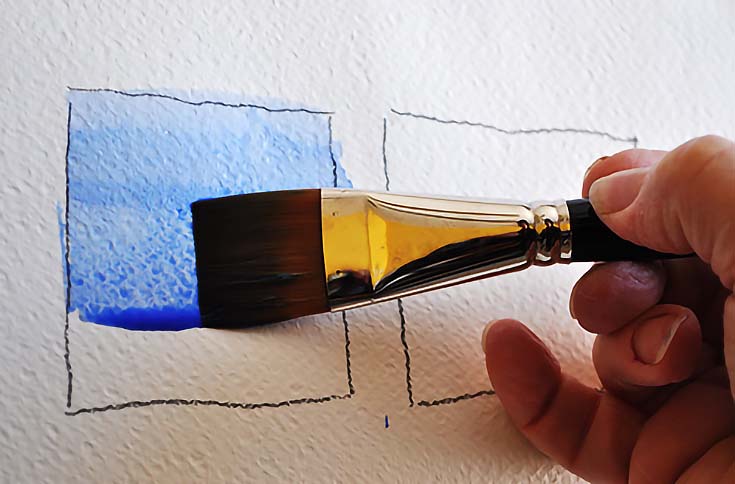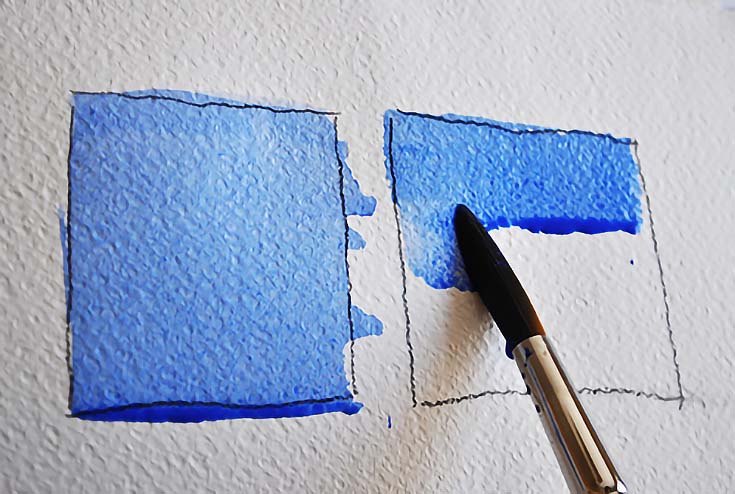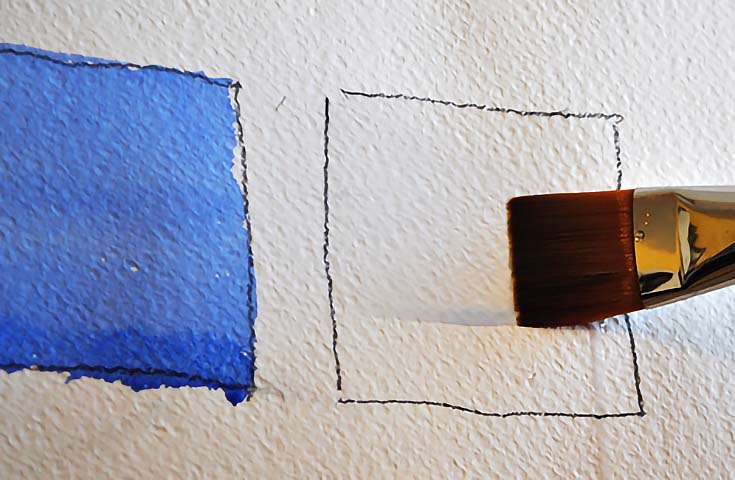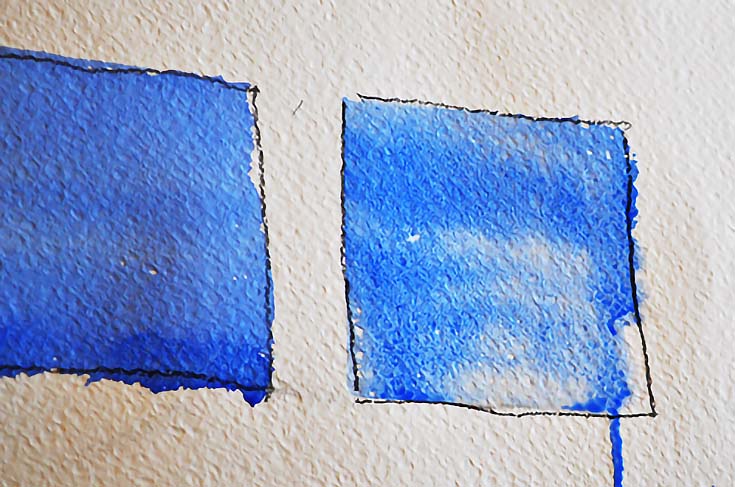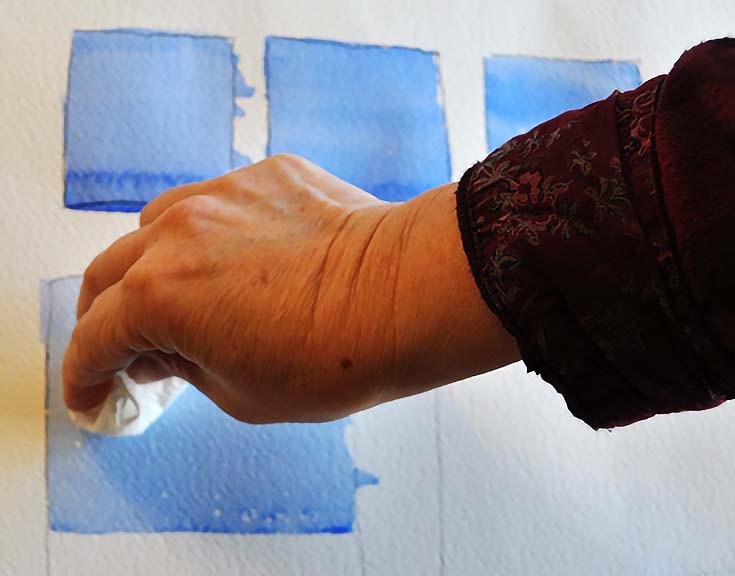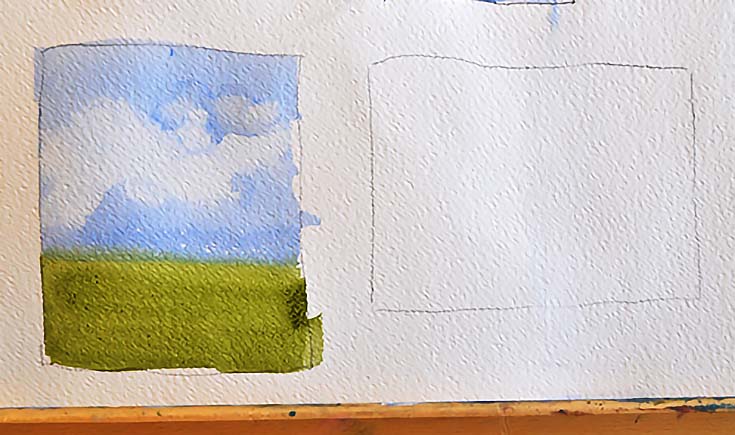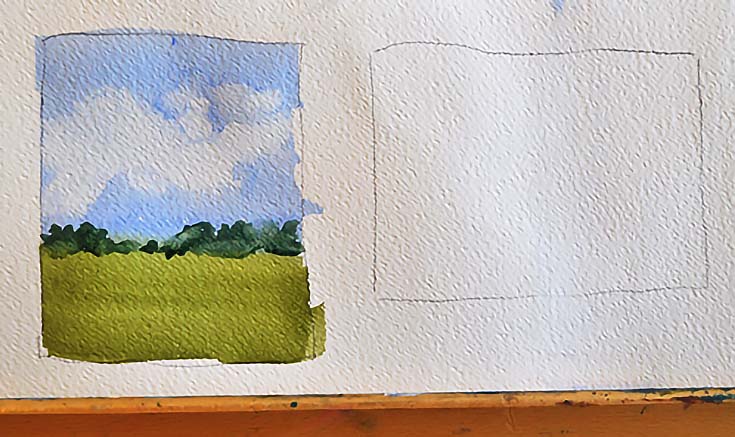A “wash” is a basic watercolor technique that will come in handy nearly every time you pick up your brush to start a new painting. Most often it is used anytime you need to cover a large area of your paper with paint.
The 3 types of watercolor washes
There are three different types of watercolor washes, and each one is applied in a different way to produce a different effect. The three types of washes are flat washes, variegated washes, and graded washes. Today I will be demonstrating how to paint a flat wash, but you can learn how to paint variegated and graded washes here if you’d like.
Creating a perfect flat wash
As the name “flat wash” implies, your aim is to end up with a “flat” or “even” wash of color throughout the entire area that you’re painting. A successful flat wash results in a seamless field of color without break, variation, or flaw.
How do you create that perfect wash? By taking into account four things:
1. The helpfulness of gravity
Smart painters use gravity to help direct the flow of their washes. With your drawing board at an angle you are always sure the paint will flow down. If your board is flat, your paint could flow in any direction. This is why I most often paint with my board tilted slightly upward—I always know which direction the paint will run.
2. The amount of paint you need
It’s a good idea to mix enough paint to cover the entire area with your wash BEFORE you start on it.
Watercolor painting is all about timing—as soon as the paint hits the paper it begins to be absorbed by the paper and starts to dry. Applying wet paint to drying paint may cause streaks, brush lines and “blossoms” that you never intended.
By having enough paint mixed at the start, you can work quickly before the last stroke gets a chance to dry. Give yourself the best chance for a great wash by mixing plenty of paint to begin with.
3. The size of your brush
Always consider your brush size. Use the largest brush you have to cover large surface areas. Not only will it take less time but you greatly increase your odds of success by using as few brush strokes as possible. (You can get a wide range of cost-effective watercolor brushes at Blick art materials.)
4. The wetness of your paper
Generally speaking, painting a wet wash on wet paper is a lot more challenging than painting a wash on dry paper. Using dry paper just allows more control—but of course, you won’t always have that option when you’re in the middle of a painting.
Go ahead and get out a piece of watercolor paper so you can see how these things affect your flat washes for yourself.
Draw several four by four inch squares on your paper—each of these will be the areas you’ll be covering in flat washes. Mix up a nice puddle of paint in your mixing area with your brush (more than you think you need) and have your paper tilted on an angle.
I like to use my flat brushes for flat washes, but I suggest you use your largest flat brush for two of your squares, and your largest round brush on the other two squares so you can compare how each type of brush affects your washes.
Painting a flat wash on dry paper
Begin in the first, completely dry square by starting at the top of one edge and painting evenly across the paper to the other edge. You should see a “bead” or “pool” of wet paint appear at the bottom of your paintbrush’s horizontal stroke.
If you apply too much paint for your board’s current angle, you’ll see drips running down from your stroke towards the bottom of your paper. You can mop up these drips with a paper towel, but you should aim to have a “bead” hanging there on the paper and no runs.
Reload your brush with paint and, touching the bead of paint as you go, pull another stroke across the square just below your other horizontal stroke. Continue in this fashion (reloading your brush each time) until you complete the square.
Do the entire process again with the round brush and note the differences.
Both the angle of your brush, and the overall wash, may be slightly changed. The edges, especially, may be harder to paint as precisely as you did with the flat brush.
Painting a flat wash on wet paper
Now that you’ve completed two flat washes on dry paper, it’s time to try it on wet paper. To start, take a clean brush, dip it in water, and paint clean water in one square.
As you’ll see in just a moment, painting on wet paper isn’t nearly as controlled as the last exercise. . . watercolors stop when they touch dry paper (giving you time to control it) and flow when they touch wet paper (staying in constant motion).
But just because you’re painting on wet paper doesn’t mean you’re not in control—you can easily use gravity to direct the flow of paint. Understanding how to paint on wet paper is important, and can be a LOT of fun!
Dip your brush in paint and painting across the square as before. You’ll see the paint flow into the wetness of the page much more quickly. You may even see a trail of paint escaping your nice, even brush stroke.
Finish up the square as you did before.
Note all the differences between the dry wash and the wet wash squares. The color is less even and consistent in the wet wash, due to paint flowing faster and collecting in different sections. There’s also paint escaping from the box entirely.
As you can imagine, in some cases you’ll want to use the wet wash, and in some cases, the dry wash. Here’s one example where a wash will come in handy.
How to paint a sky using a flat wash
I frequently paint a flat wash for my sky, and then dab out clouds with my paper towel. (Yes, your paper towel isn’t just for cleaning!) A loosely-crumpled paper towel can lift paint up, revealing white paper in the shape of gorgeous, fluffy clouds!
Here’s how to do it.
Mix a puddle of watery French Ultramarine Blue. Use a flat brush to paint the top two-thirds of a square or rectangle using the dry flat wash technique. Use your paper towel “dab” out a few white fluffy clouds. Voilà, sky!
Let your wash dry completely. Then, using another flat wash of Permanent Sap Green, paint the bottom third of the square. Voilà, land! Let this wash dry completely, too.
To finish this simple landscape, mix a watery little puddle of Sap and Ultramarine to get a blue-green color. Use a round brush and “dot” a tree line along the horizon.
Now, pull down some broken furrow lines in the field. Voilà, your first landscape!
And this is just one way to use flat washes—in nearly every painting situation, you’ll need to cover areas of paper with smooth washes of color.
Remember, practice makes perfect!
Watercolor painting is challenging, but you cannot learn until you make mistakes. Keep painting! (These small exercises are perfect for developing your skills, so don’t hesitate to fill your paper with several more “flat wash” landscapes.) As you practice, you will make fewer mistakes and have more control.
Have fun!
This post may contain affiliate links.
